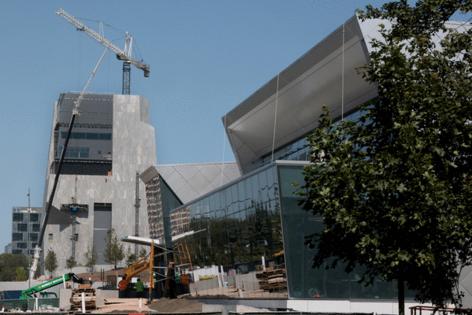Obama center construction tab reaches $615 million as opening nears
Published in News & Features
CHICAGO — The cost to build former President Barack Obama’s namesake center campus rose to $615 million through the end of 2024, according to the latest reports from the Obama Foundation, quickly nearing the total construction budget as fundraising efforts continue to bring massive amounts of money into the foundation’s coffers.
That cost is more than double the earliest $300 million estimate from when the center was first contemplated. Foundation officials revised the estimate up to $500 million when the design was unveiled in 2017, then again in 2021 to $700 million for construction costs alone.
At the time, another $90 million was needed to prepare artifacts, exhibits and open the center itself, foundation officials said. $40 million would be needed for the first year of operating costs for the center in Jackson Park, officials said, bringing the center’s budget to $830 million. The foundation’s most recent all-in estimate is $850 million, foundation spokeswoman Emily Bittner said.
The latest construction cost was included as part of the foundation’s annual disclosure of its fundraising and spending documents and annual report, which the organization released late last week.
After years of delays and legal fights, the center is scheduled to open its doors to visitors in the spring. Obama officials are hosting community tours beginning late this month so neighbors “can begin to imagine how they will use and enjoy” the center.
When finished, the campus will include the main building housing the museum; a forum building that includes an auditorium, media suite and other programming rooms; a Chicago Public Library branch; and further south, a 45,000 square foot multipurpose athletic center.
That athletic center was supposed to open later this year, but foundation officials revised the opening date to 2026 earlier this summer. “We are planning to fully open the campus as a whole in the spring of 2026,” Bittner said.
Valerie Jarrett, the foundation’s CEO, told the Tribune in March 2024 that construction of all the buildings should be finished by the end of this year. Exhibit installations started across several floors of the museum this year, according to the foundation’s website, as has lighting and interior granite work in the forum building, drywall at the athletic center, and trees and playground equipment across the grounds.
The towering, 83-foot painted glass window by artist Julie Mehretu on the exterior of the museum building has also gone up.
Fundraising efforts have continued apace — the foundation’s net assets surpassed $1 billion for the first time after raising $195 million last year, according to the report.
That came from nearly 92,000 donors, the foundation said. More than 56,000 gave for their first time. The most common amount was $25. The foundation added more than 100 donors that gave more than $1 million, according to its website. The exact amounts are not specified.
Expenses have ticked up at the foundation as well. On disclosures to the Internal Revenue Service, the foundation reported spending about $27.5 million on programming, which includes its scholarship, leadership, and youth engagement programs.
“335 changemakers from around the world completed our Global Leadership Programs, including the Obama Leaders, Scholars and Voyagers,” the foundation said in a release. “They have joined the growing Obama Leadership Network of more than 1,500 alumni from 150 nations and territories.”
Total compensation for top ranking executives rose to $6.1 million in 2024, up from $5.1 million a year prior. A previous Tribune analysis found Obama Foundation leaders are some of the best paid among modern presidential foundations and local museums and cultural institutions.
CEO Valerie Jarrett was paid $740,000 last year. OPC Executive Vice President Robbin Cohen earned $610,195 and Tina Chen, the organization’s chief legal and people officer, earned about $425,000.
Nearly half of workforce hours — 49% — were performed by city residents. A total of 33% of workforce hours came from workers on the city’s South and West Side, according to the report. That’s slightly below the foundation’s promised levels, 50% and 35%, respectively.
_____
©2025 Chicago Tribune. Visit chicagotribune.com. Distributed by Tribune Content Agency, LLC.







Comments